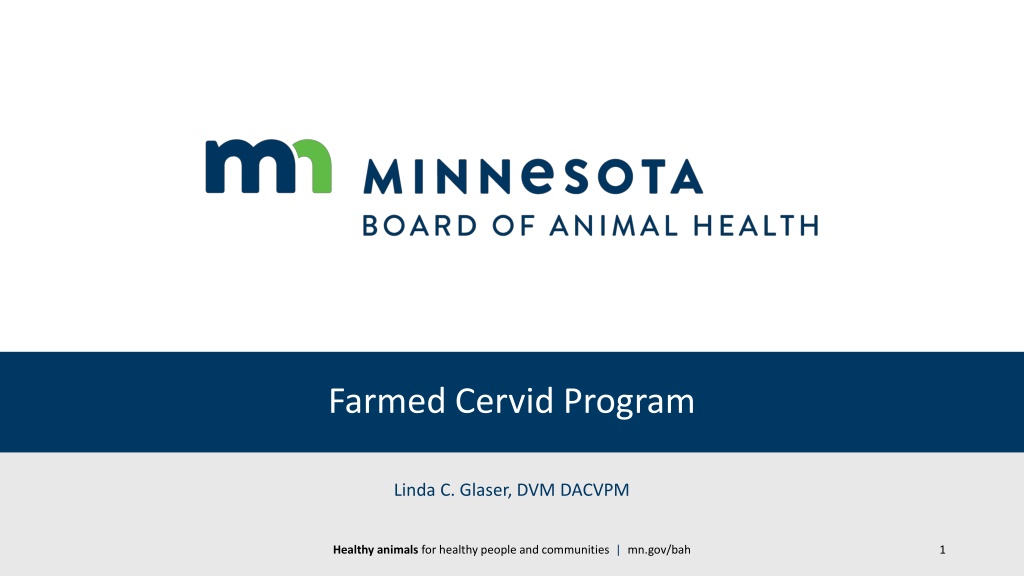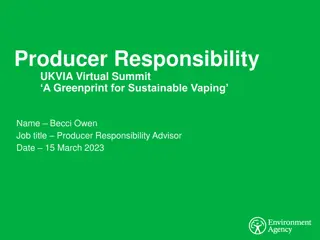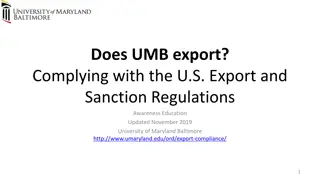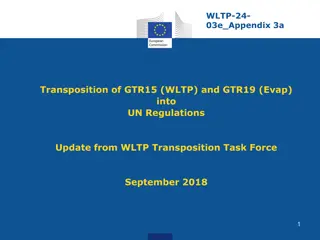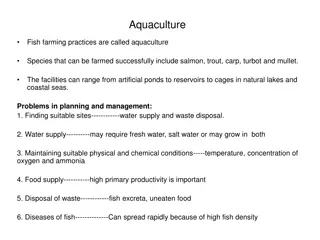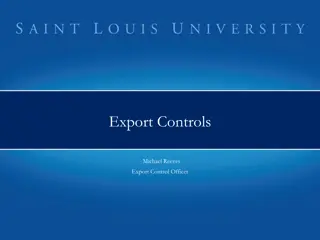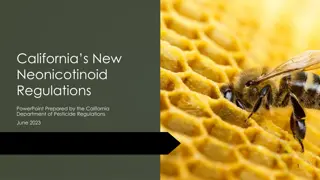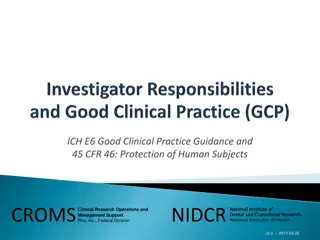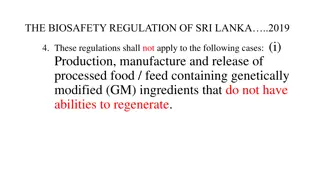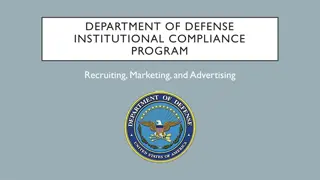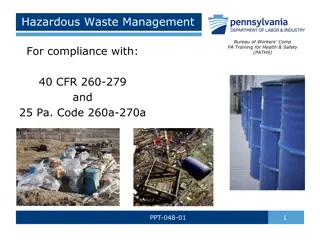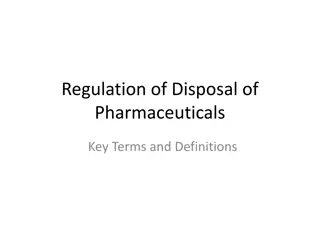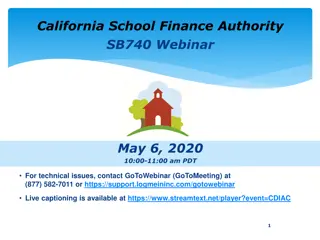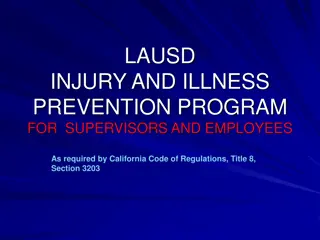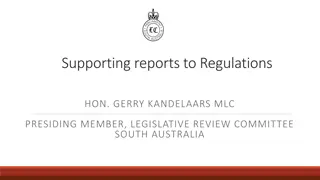Farmed Cervid Program Overview and Regulations
The Farmed Cervid Program, led by Linda C. Glaser, DVM DACVPM, focuses on promoting healthy animals for the well-being of people and communities in Minnesota. The program, governed by laws effective since 2004, treats farmed cervids as livestock and involves their confinement, management, and regulated movements between states. The Department of Natural Resources (DNR) plays a crucial role in overseeing the program by addressing escapes, approving red deer requests, and inspecting farmed cervidae. Recent collaborations, such as the MOU with the DNR, aim to enhance communication, roles, and science-based decision-making for the benefit of all stakeholders.
Download Presentation

Please find below an Image/Link to download the presentation.
The content on the website is provided AS IS for your information and personal use only. It may not be sold, licensed, or shared on other websites without obtaining consent from the author.If you encounter any issues during the download, it is possible that the publisher has removed the file from their server.
You are allowed to download the files provided on this website for personal or commercial use, subject to the condition that they are used lawfully. All files are the property of their respective owners.
The content on the website is provided AS IS for your information and personal use only. It may not be sold, licensed, or shared on other websites without obtaining consent from the author.
E N D
Presentation Transcript
Farmed Cervid Program Linda C. Glaser, DVM DACVPM Healthy animals for healthy people and communities | mn.gov/bah 1
Program Background The Board laws for the program were effective 1/1/2004. Prior to that the DNR had the program Farmed cervids are considered livestock under Minn. Stat. 17.452 Subd. 4. Farmed Cervidae are livestock Subd. 5. Raising farmed Cervidae is an agricultural pursuit. Farmed cervidae include all cervidae species including: Deer Elk Moose Reindeer 10/7/2024 Healthy animals for healthy people and communities | mn.gov/bah 2
Agricultural Pursuit Animals are confined and managed so feeding, housing, breeding, disease treatment and prevention are controlled Cervid movements between states must be accompanied by paperwork so state governments can track and verify movements Animals are used for multiple purposes: breeding, trophy harvest, meat production, exhibition, antler velvet collection, pets 10/7/2024 Healthy animals for healthy people and communities | mn.gov/bah 3
DNR Responsibilities per Minn. Stat. 35.155 Subd. 1. Regarding escapes, DNR may destroy animals if not recaptured within 24 hours of escape Subd. 2 Producers must destroy any wild animals in their enclosure and report it to the DNR Subd. 3. The DNR approves requests for farmed red deer north of US Hwy 2 in native elk habitat Subd. 6. The Board will provide copies of registration information to the DNR upon request. Subd. 7. The DNR may inspect farmed cervidae and their records with reasonable suspicion that laws protecting native wild animal have been violated Subd. 10. Cervidae possessed in violation of this section may be seized and destroyed by the DNR Subd. 11. Cervidae imported in violation of this section may be seized and destroyed by the DNR 10/7/2024 Healthy animals for healthy people and communities | mn.gov/bah 4
BAH DNR MOU Recently signed a MOU with the DNR to coordinate: Communication among staff Roles and responsibilities Sharing of information Science-based decision making 10/7/2024 Healthy animals for healthy people and communities | mn.gov/bah 5
Farmed Cervid Numbers (End of SFY18) Species Herds Animals Avg. Herd size Elk 87 3623 42 WTD 238 2052 9 Other Species, Mixed 70 2331 33 TOTAL 395 8006 20 10/7/2024 Healthy animals for healthy people and communities | mn.gov/bah 6
Healthy animals for healthy people and communities | mn.gov/bah
Healthy animals for healthy people and communities | mn.gov/bah
Regulations for the program MN State Statutes (35.155) MN Rules effective April 2013 (1721.0370 0420) Mandatory registration Herd Inventories Annual Inspection Sales of farmed cervids for slaughter Response to escaped farmed cervids Record keeping Wild cervids in an enclosure Quarantine procedures for infected herds Fencing Defining a CWD Endemic area Animal Identification CWD surveillance Importation of farmed cervids 10/7/2024 Healthy animals for healthy people and communities | mn.gov/bah 9
Staffing/Funding for the program 2 veterinarians oversee program out of the St. Paul office 2 office support staff 11 Board field staff / 8 USDA field staff $32,000 taken in yearly from producer inspection (registration) fees State cost in salaries / benefits / equipment / CWD Testing SFY17 - $550K SFY18 - $675K 10/7/2024 Healthy animals for healthy people and communities | mn.gov/bah 10
Record Keeping Producers must keep records for 10 years Name and address of buyers and sellers of farmed cervids Submit Movement Report to the Board Submit Death Report or CWD Test Submission form to the Board Yearly Inventory of animals in the herd with all ID 10/7/2024 Healthy animals for healthy people and communities | mn.gov/bah 11
Inspection Components Inventory Fencing Record keeping Animal identification Movement reports Death Reports CWD Testing 10/7/2024 Healthy animals for healthy people and communities | mn.gov/bah 12
Escapes Owner may not allow farmed cervids to run at large. Owner must notify the DNR and BAH if cervids not returned in 24 hours If the owner unwilling or unable to capture cervids, the DNR may destroy the animal as soon as 24 hours after the escape. 10/7/2024 Healthy animals for healthy people and communities | mn.gov/bah 13
Escape Data SFY 2018 # Escaped # Returned # Killed # Lost # Killed Tested and Results 10 WTD farms 42 20 18 4 12 Not Detected, 2 Unacceptable, 3 not tested, 1 = <1yo, 3 elk farms 12 2 10 0 7 Not Detected, 3 = <1yo SFY 2019 to date # Escaped # Returned # Killed # Lost # Killed Tested and Results 3 WTD farms 14 8 6 0 6 Not Detected 3 elk farms 29 27 2 0 2 Not Detected 10/7/2024 Healthy animals for healthy people and communities | mn.gov/bah 14
Mandatory CWD Surveillance 100% surveillance required / BAH pays lab test cost for each sample submitted. SFY17 - $38K / SFY18 - $44K If eligible animals not tested, surveillance period is advanced. If samples do not provide successful results, surveillance period is advanced. Egregious disregard for sampling, producer s herd status for CWD can be dropped In 2019, there will be a training program to authorize sample collectors. 10/7/2024 Healthy animals for healthy people and communities | mn.gov/bah 15
10/7/2024 Healthy animals for healthy people and communities | mn.gov/bah 16
CWD Positive Herds in Minnesota Winona -9 Lac Qui Stearns -1 Parle -1 Ramsey -1 Crow Wing - 2 Olmsted -4 Aitkin - 1 Meeker -5 Elk Mule Deer Red Deer WTD 2006 2002 2010 2014 2018
10/7/2024 18
Questions? Healthy animals for healthy people and communities | mn.gov/bah 19
